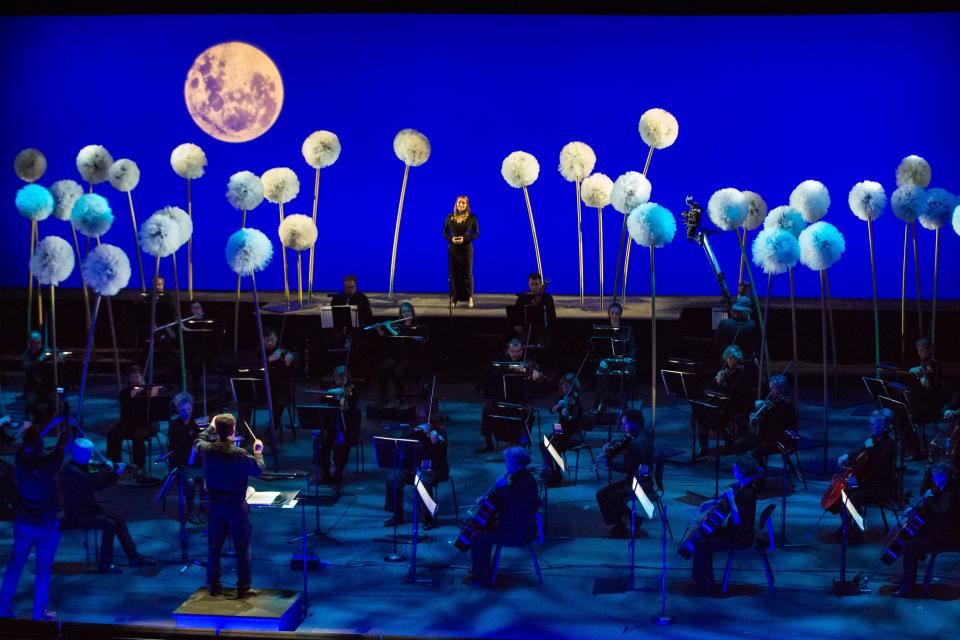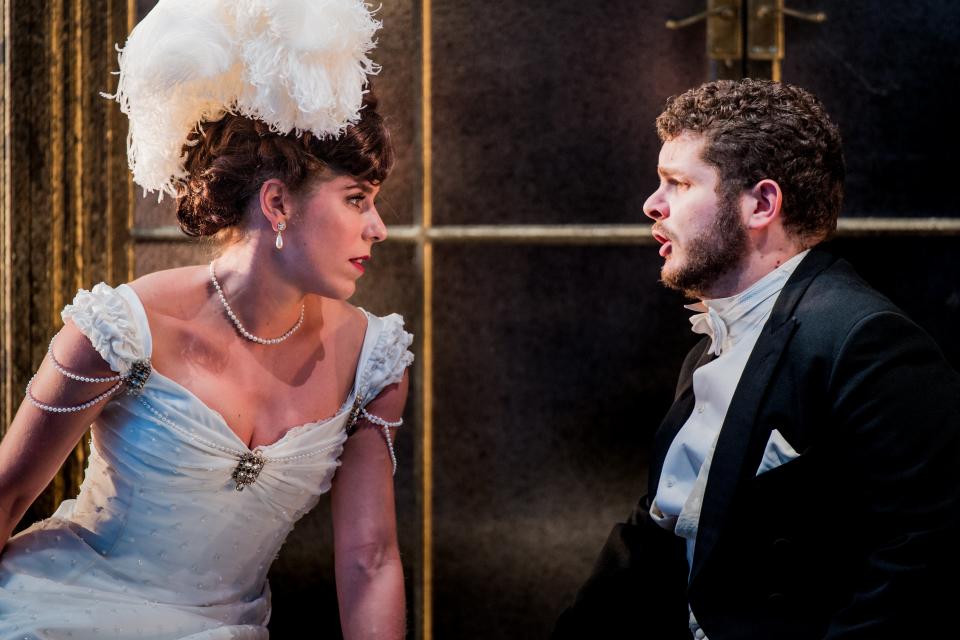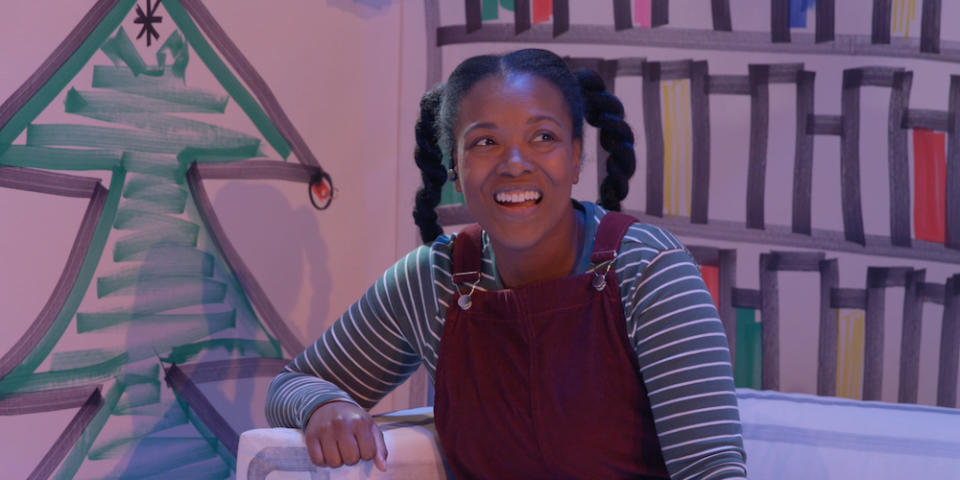‘I’ve never worked so hard, fast and flexibly’: How the opera world is facing its post-Covid future

ENO Breathe, a collaboration with Imperial College to help long-Covid sufferers
(ENO)We’re told that the way out of Covid is to follow the data, not the dates, but when the dates are provided in such precise detail, it’s not easy to ignore them. That‘s why theatres across the UK are gearing up for a potential reopening on May 17, with the possibility of full audience capacity on June 21, as Boris Johnson announced last week, albeit with caveats.
After a year of theatres being dark, that will demand a quick turnaround for theatre managements, not least when it comes to opera. We’ve become used to online opera, but live shows present new challenges, from singers projecting microdroplets as they perform, to social distancing in auditoriums, onstage and in orchestra pits. These are issues for all opera companies, not least the Royal Opera and English National Opera (ENO), who also have to navigate problems caused by post-Brexit visas and quarantine regulations for singers arriving from abroad. These may not be such significant obstacles for companies working on a smaller scale, but they have plenty of other worries, not least money.
Yet just as 2020 forced everyone to adapt, so the new circumstances demand imagination. Annilese Miskimmon joined ENO last May, mid-pandemic. As artistic director, she was thrown in at the deep end and has been involved in some notably innovative projects: a drive-in staging for Puccini’s La Bohème, for example, at Alexandra Palace in September, and its ‘ENO Breathe’ collaboration with Imperial College Healthcare NHS Trust, which uses singing techniques to help long-Covid sufferers.

As Miskimmon says: “It’s been a strange, painful and difficult time, but I think it’s girded our loins and we’ve had some joyous moments that we’ll build on in the future. I’ve never worked so hard, so fast and so flexibly, but it’s been so moving to see, for example, people involved with the Imperial College project: never in their wildest dreams did they think that they’d be using opera to support them psychologically and physically. It’s been life-changing for them and for us.”
ENO’s home, the London Coliseum, is the city’s largest theatre, with a seating capacity in excess of 2,000. That will be halved under social distancing rules, but Miskimmon feels the company will be able to cope: “We trialled a socially distanced audience before the second lockdown, so we now have amazing health and safety expertise. We will try to find the sweet spot so as to be able to reopen but with 50 per cent capacity. Our protocols are strong – and we will continue working on them.”
The impact that social distancing will have on income will be a major headache for all theatres. Some opera companies have benefitted from the Government’s furlough scheme, and some have accepted loans from the Culture Recovery Fund (CRF): the Royal Opera House received £21.7m, ENO £8.5m. Not everyone has been so fortunate. OperaUpClose , for example, received a modest but welcome grant from the emergency response package back in April 2020, but was turned down for a CRF loan.
As the company’s artistic director Robin Norton-Hale suggests: “Perhaps we didn’t look stable enough before Covid. Or perhaps because we had managed to stabilise, we didn’t look as though we needed it enough. We were lucky that our tour of Puccini’s Madam Butterfly finished the week that lockdown was announced. We don’t have the reserves or the government support so if we hadn’t had the box office income from those performances, that would have been it for us.”

Opera Holland Park, meanwhile, is happy to get by with as little government help as possible. James Clutton, its director of opera, says: “The furlough scheme has helped, and we haven’t made any redundancies. But as far as a loan from the government goes, I like it that we’re answerable to our Friends, our Members and our audiences rather than to another organisation.”
By contrast, Tête-à-Tête, the annual festival of new opera, is fortunate in being in Arts Council England’s “national portfolio”. Its regular funding enabled it to mount a complete programme of shows, live and online, in 2020, something of which artistic director Bill Bankes-Jones is proud: “In November 2019, I basically had a festival ready to go in the following September. It was the earliest I had ever planned it. Then Covid came along and it quickly became obvious that nobody would be able to do shows with lots of performers. There was a month of panic but we ended up with a festival of 31 new operas, 19 live, the rest online only. Quite a lot of organisations drew on quite a lot of money last year in order not to do anything. We did pretty much what we would do every year.”
And what about 2021? “I hope that this year’s Tête-à-Tête will be a similar size to last year. The biggest thing we learnt last year is that we need to make sure that artistic integrity survives in the face of whatever Covid does. In a way opera in general is somewhat ossified: there is so much time and money invested in planning that an element of – not even spontaneity but reaction has been taken out. Long-term planning is invaluable when you want to do things on a big scale, but it’s less valuable for being in the moment.”

Yet even the largest organisations have had to be light on their feet. One thing that all these companies share is an eagerness to get back onstage, no matter how big or small that stage is. At the Royal Opera, Oliver Mears, director of opera since 2017, is among them: “So many people in our building are itching to make work again. Now we have a timeline. There may be bumps in the road, but we’ll be able to open up for audiences: that’s an amazing and hopeful end to the turbulent year that we’ve had.”
Most companies haven’t yet announced specific plans for the coming months, but even before the latest government ‘roadmap’ emerged on February 22, Clutton, of Opera Holland Park, had announced dates and repertoire for the company’s 2021 season: “That was optimistic, but it wasn’t blind optimism. We were working on these plans last September. My thinking was to go radical and go early.” It helped that the company’s theatre is a canopy that is partly open to the fresh air. “We’ve spent 20 years trying to make the theatre more ‘indoors’; now in a year, we’ve made it more ‘outdoors’: we’re taking the sides off the theatre. On top of that, we’ve made all the seating individual seats so that we can group them to make family bubbles.”
In the process, the theatre’s capacity has reduced from 1000 to 400. For Fiona English at the King’s Head Theatre, a small room at the back of an Islington pub, the seating problem is particularly acute: “The way things are now, there is no long-term future for us in our 110-seat theatre; social distancing is nigh-on impossible. And because you access the theatre through the pub, we’re in an even more difficult position.”

Long before Covid came along, the company planned to move to larger premises in a new development behind the current building on Upper Street. Lockdown has inevitably caused delays, but, English says, “the aim is to open in Spring next year, which is more realistic than hoping we could be in this year. The new theatre will have 235 seats, which is dramatically different. We hope that, in our slightly grimy, rough-around-the-edges way, we can get our kind of intimate opera into what is, externally at least, quite a posh development.”
In the meantime, the theatre will present a digital programme – not entirely operatic – in collaboration with ‘visiting’ companies, as well as some outdoor shows for local audiences. Throughout the performing arts, digital has become increasingly important, not least at the Royal Opera, where Mears says: “We expect that people’s appetite for digital work will diminish once they’re allowed back into theatres, but digital will remain part of what we do. If we can achieve a national impact through digital, we feel that there is real value in that, in and of itself, but we’re also curious about what form opera can take online. That’s not just an artistic imperative, it’s potentially a financial imperative: the rewards can be great if we get it right and the content is of exceptional quality. We have to be realistic: the epidemiologists tell us that pandemics could become more frequent. If that’s true, digital opera, digital art in general, may be even more significant in future.”
Not everyone is entirely happy about the amount of digital work offered free, albeit with the option to donate, by companies such as the Royal Opera and the National Theatre (both of which now charge). At the King’s Head, English is concerned: “I don’t necessarily agree with the really large-scale companies making their work available for free. That cheapened the idea of art. I don’t think we as an industry should be trying to compete with Netflix and it’s disappointing that we chose to, particularly the big guys.”
Norton-Hale echoes the point: “The National Theatre put a huge amount of their back catalogue out for free in the early part of the first lockdown. Very quickly there was an expectation that other companies should do it as well. The National Theatre and the Royal Opera House already had a relationship with on-demand cinema screenings; maybe that means that people think it’s quite easy to do. We didn’t have a back catalogue that we could either share or monetise, and that’s a problem for many small to mid-scale companies. In future, though, every production will be filmed, even if it won’t look like a Royal Opera House film production.”
In the coming weeks we’ll learn what ENO and the Royal Opera are planning, but whatever the differences between all these companies, ambition is not in short supply; change must and will happen. As Mears puts it: “There’s an imperative to engage with the many problems that we face as a society. That could be an exciting manifesto for the future: to provide the spectacle that our audiences rightly demand, but with less extravagant – less decadent, dare I say – sets and mise-en-scène.”
Opera with less extravagance? For some, that will be a loss, but as small-scale opera companies have long demonstrated, emotional impact is not dependent on lavish resources. That may well be the defining lesson for post-pandemic opera.
Read More
No laughing matter: London’s comedy clubs on the fight for survival during Covid-19
Brexit and the arts: why the battle isn’t over for this beleaguered industry
The arts crisis is deepening — but there are solutions to stopping a cultural catastrophe

 Yahoo Sport
Yahoo Sport 





































